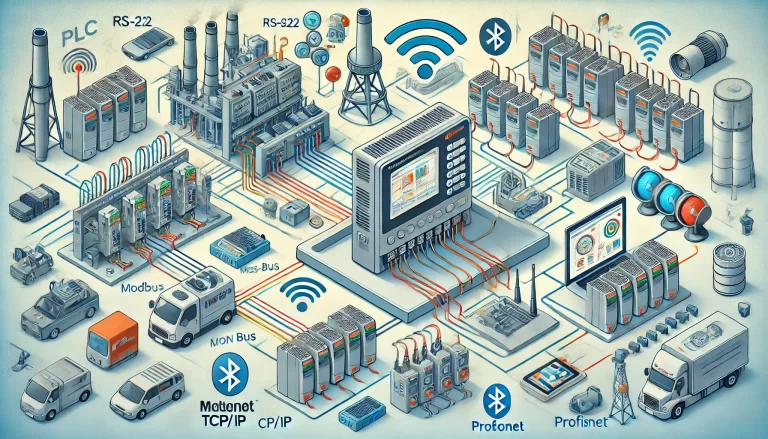Foundation Fieldbus (FF) is a digital, bidirectional, multi-drop communication protocol widely used in industrial automation, particularly in process control systems. Developed and maintained by the Fieldbus Foundation, it has become a cornerstone for achieving efficient and reliable communication between field devices and control systems in industries such as oil and gas, petrochemicals, power generation, pharmaceuticals, and more.

Key Features of Foundation Fieldbus
Digital Communication:
- Unlike traditional analog signals (e.g., 4-20mA), FF uses digital communication, ensuring precise and noise-free data transmission. This allows devices to exchange more detailed information than just a single measured value, such as diagnostics, configuration data, and operational status.
Multi-Node Capability:
- FF supports the connection of multiple field devices (e.g., sensors, actuators) on a single network. This reduces the complexity and cost of wiring while enabling devices to interact seamlessly.
Distributed Control:
- A standout feature of FF is its ability to distribute control functionality to field devices. For example, a field device can perform PID control locally, reducing reliance on centralized control systems. This enhances system reliability and efficiency.
Bidirectional Communication:
- FF allows devices to send and receive information simultaneously. Devices not only transmit measured data to the control system but also receive operational commands, calibration instructions, or configuration updates.
Interoperability and Open Standards:
- Foundation Fieldbus adheres to international standards like IEC 61158 and IEC 61784, enabling devices from different manufacturers to operate together in the same network without compatibility issues.

Foundation Fieldbus Architecture
The FF system is structured into two main types of networks:
H1 Network:
- Speed: Operates at 31.25 kbps.
- Purpose: Connects field-level devices like transmitters, actuators, and sensors.
- Physical Layer: Uses a two-wire system for transmitting both power and communication signals, simplifying wiring requirements.
- Characteristics: Typically used in process industries due to its robustness and ability to operate in harsh environments.
HSE (High-Speed Ethernet) Network:
- Speed: Operates at 100 Mbps.
- Purpose: Facilitates high-speed communication between control systems, gateways, and other supervisory layers.
- Characteristics: Used in applications requiring fast data transfer, such as plant-wide monitoring and enterprise integration.
Comparison: Foundation Fieldbus vs. Traditional 4-20mA Analog Signals
| Aspect | Foundation Fieldbus | 4-20mA Analog Signal |
|---|---|---|
| Communication Type | Digital | Analog |
| Device Connectivity | Multiple devices on one loop | One device per loop |
| Data Transmission | Multivariable (values, diagnostics, etc.) | Single variable (e.g., current) |
| Control Distribution | Yes | No |
| Wiring Complexity | Low (shared network) | High (dedicated loops) |
| Noise Susceptibility | Low | High |
Advantages of Foundation Fieldbus
Reduced Wiring Costs:
- A single FF cable can support multiple devices, significantly reducing the amount of wiring and installation costs.
Enhanced Diagnostics:
- FF devices provide detailed diagnostic and status information, enabling predictive maintenance and reducing downtime.
Improved System Reliability:
- Distributed control and reduced dependency on a central controller make the system more fault-tolerant.
Scalability and Flexibility:
- Adding new devices to an FF network is straightforward and does not require major changes to the existing infrastructure.
Energy Efficiency:
- FF’s shared power and communication design minimizes energy usage compared to traditional systems.

Challenges and Limitations
Higher Initial Cost:
- The upfront cost for FF-compatible devices and systems is higher compared to traditional analog systems.
Complex Configuration:
- Setting up and configuring FF networks require specialized expertise, which may increase training and operational costs.
Dependence on Specialized Knowledge:
- Maintenance and troubleshooting of FF systems often require skilled personnel familiar with the protocol and tools.
Applications of Foundation Fieldbus
Foundation Fieldbus is particularly suited for environments where reliability, precision, and operational flexibility are critical. Key applications include:
- Oil and Gas: Monitoring and controlling flow rates, pressures, and temperatures in pipelines and refineries.
- Pharmaceuticals: Ensuring precise control over production parameters to meet strict regulatory standards.
- Power Generation: Managing turbines, boilers, and emission controls.
- Chemical Processing: Monitoring and automating complex chemical reactions.

Conclusion
Foundation Fieldbus has revolutionized industrial automation by providing a robust, efficient, and scalable communication framework. Its ability to support digital, bidirectional, and distributed control has made it a preferred choice for industries looking to enhance operational efficiency and reliability. While it requires a higher initial investment and technical expertise, the long-term benefits in terms of reduced downtime, maintenance costs, and improved process performance often outweigh the challenges.
As industrial automation continues to evolve, Foundation Fieldbus remains a critical enabler for smart factories and Industry 4.0.
